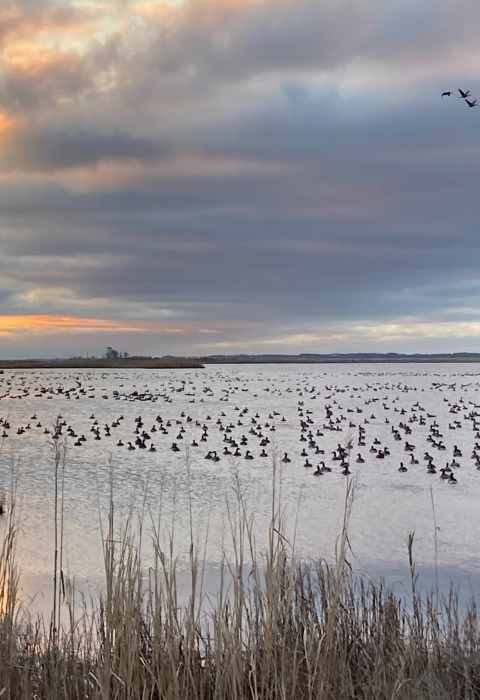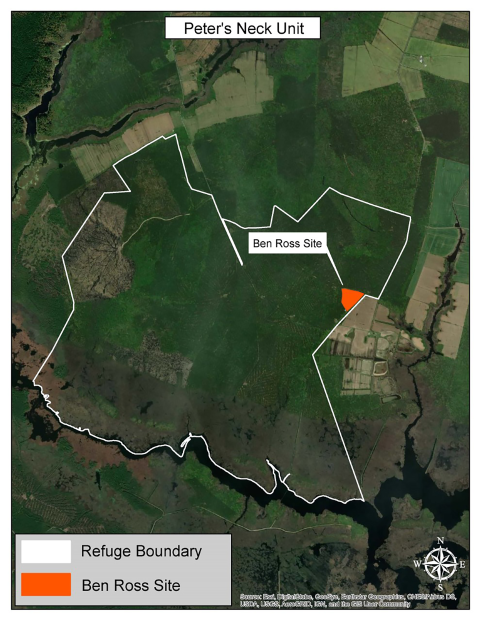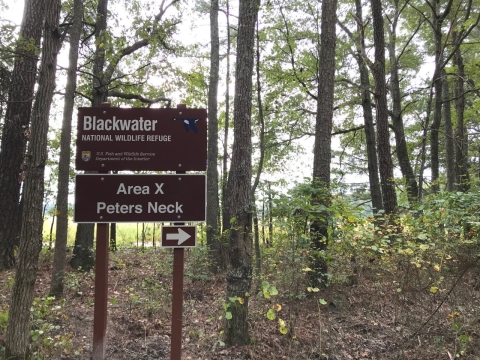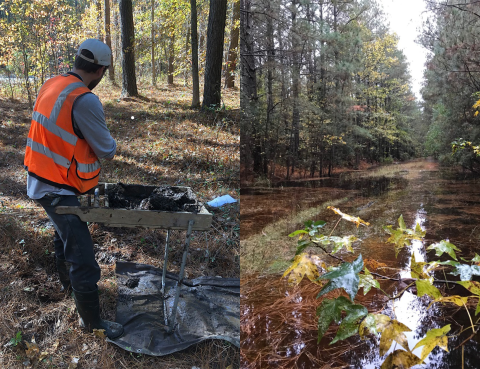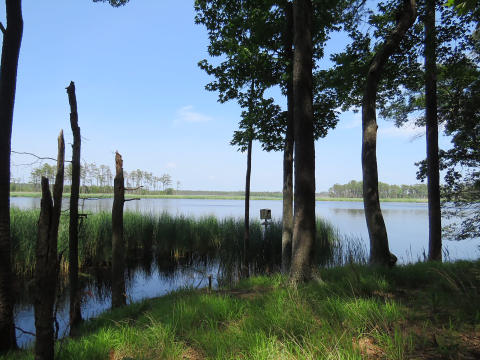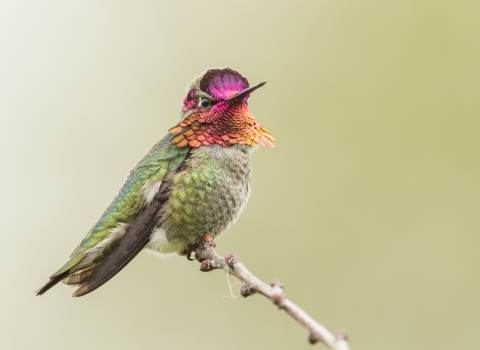In October 2020, after years of negotiations, the U.S. Fish and Wildlife Service partnered with The Conservation Fund to acquire an additional 2,691 acres of forested wetlands to be added to Blackwater National Wildlife Refuge. The parcel will provide essential habitat for migrating shorebirds, waterfowl, and other native species. Wildlife aren’t the only ones, however, that benefit from the riches of these lands. Beneath the soil there are deep historic roots that may help us piece together previously untold stories.
For years, Blackwater National Wildlife Refuge has worked alongside the Harriet Tubman Underground Railroad State Park and Harriet Tubman Underground Railroad National Historical Park, preserving the landscape associated with Harriet Tubman’s childhood. The newly acquired lands, formerly managed for forests and hunting, have been on their radar for nearly 20 years. Based on previously gathered historical deeds, court, birth, and census records, the partnership believes that within those 2,691 acres are the 10 acres Harriet Tubman’s father, Ben Ross, received when released from slavery.
“Whether or not it’s the land that Ben Ross owned, there’s a story to be told there,” says Chesapeake Marshlands National Wildlife Refuge Complex Leader Marcia Pradines. “We know this is the place where she grew up, where she learned about surviving on the land.”
During their second exploration in the Spring of 2021, the Maryland Department of Transportation’s archeological team, led by chief archaeologist Julie Schablitsky, confirmed that they had officially discovered the location of Ben Ross’ cabin.
Making up for lost time
The property has undergone a remarkable transformation and today looks far different from the landscape Tubman would have known. What were once irrigation ditches now gather water as the land is threatened by sea-level rise.
The ever-rising waters are largely the motivation behind the land acquisition.
“The reason why this land is so important, strictly from a habitat perspective, is that it will be at least partially marsh by 2100,” Pradines says.
The saturated site houses flourishing ecosystems teeming with wetland wildlife. Although ideal for migrating waterfowl, this swampy terrain is a hazard to researchers. As the water rises, so too does a sense of urgency. Refuge staff and partners now race against the clock as water threatens to wash away pieces of history.
Extracting the past is a task that takes extraordinary care.
“As an organization, we are largely pretty light on the landscape so there exists potential for a great number of breakthroughs,” says our Regional Historic Preservation Officer Amy Wood “Not excavating is always our first option. In archaeology, once we start to remove anything, information is lost. That’s why we get so upset when there’s damage done to a dig site. It’s not just the items, it’s the context in which you find them. If you damage the area you automatically lose 50 percent of the information.”
The longer they wait, the more of this land erodes. If artifacts aren’t lost to the erosion that 50 percent, the contextual information, will be.
Action and exploration
Once the parcel officially became Service property in the fall, refuge leadership sprang into action, completing the necessary paperwork and ensuring archaeological exploration was appropriate for their management goals. The team avoided habitat disturbance by digging the initial 700 pits along existing 200-year-old roads that will one day be converted into a public use trail system.
As shared public lands, maintenance staff worked tirelessly, says Pradines, improving roads, posting signage, and creating parking spaces not only for hunters but for researchers as well, ensuring everyone would have safe access to their designated areas.
During that initial dig the archaeological team including biographers, students, and historians, unearthed several compelling artifacts, including shards of ceramic dishes and an 1808 coin. Despite their best efforts to comb the muddy, unforgiving landscape, they had not found substantial evidence of the Ross cabin.
With the threat of sea-level rise only steps behind them, the archaeological team returned to the refuge in March of 2021 to continue their search. After unearthing numerous key artifacts dating back to the 1800’s, archeologists were thrilled to confirm that they had officially found the location of Ben Ross’ cabin.
Puzzling through pieces of history
Though they may seem small, a simple coin or a piece of clay may be invaluable historical clues. By piecing together similar shards of history, we can learn a lot about our ancestors including what materials they used to build their homes, what they did for work, what they did for pleasure, and overall how they lived. We can even track the movements of people across the greater landscape. For example if we find a tool only manufactured in Ohio buried in a swamp in Virginia, we get a better understanding of who was traveling where.
Even the wildlife holds clues that help us fill in the gaps of history. Crops that were planted, new animals introduced to an area, all of this can be discovered when we study the land.
The land holds scars, evidence of the interactions between people of the past and the habitat that they occupied. For that reason, land conservation and historical resource conservation are intrinsically linked. When we preserve these habitats, we are inevitably preserving stories. By reading these landscapes, we discover more about people like Harriet Tubman whose stories are interwoven in and deeply connected to the land.
In this case, a few key artifacts including nails, brick, glass, dish fragments, and even a button provided enough evidence to prove that this location had once held Ben Ross’ cabin. Through their continued research of this property, the archeological team hopes to discover more about Harriet Tubman’s upbringing.
These are the places where she learned the necessary skills to emancipate over 70 enslaved people. Under these stars she learned to navigate. In these forests she learned how to traverse the wilderness, find food to sustain herself, and hide among the trees. Working alongside her father who felled and sold timber for Baltimore shipyards, Tubman learned how to navigate the terrain. When interacting with mariners she garnered knowledge of Maryland’s waterways. These spaces, as much as the people around her, helped raise her into the leader she would eventually become.
Unearthing the unwritten and grounding history
As a society, we predominantly study history from written accounts. In doing so, however, we ignore the rich histories of people whose stories may have never reached the page. Enslaved people were largely illiterate, forcibly kept from written language by slave masters who sought to deprive them of education in order to avoid potential uprisings.
By preserving historical sites we help ensure that these stories will not be forgotten. The physical evidence on the land gives us greater insight specifically into the lives of people whose stories have never been documented.
The cultural significance of land, however, is not simply determined by what we find on it. When we hold spaces, even those that were once sites of trauma, we create space for healing and unity. By recognizing the significance of certain locations we provide an opportunity for people of all backgrounds to gather and acknowledge both the painful and triumphant moments that occurred there.
In honoring these stories we recognize the significance of histories unwritten. We ensure true stories are told and uphold collective memory, painting a fuller picture of American history. These locations provide the roots. They give us an opportunity to grow, something that can only be accomplished if we recognize what we once were and where we need to grow from.
Telling the story
When the location is visitor ready, the site will be added to the Harriet Tubman Underground Railroad Byway. This byway is a 125-mile, self-guided scenic drive through more than 30 sites related to Harriet Tubman’s life and legacy.
Additionally, Blackwater National Wildlife Refuge seeks to honor this historic location by working alongside the Harriet Tubman Underground Railroad State Park and Harriet Tubman Underground Railroad National Historic Park to develop interpretive trails. As a land management organization, the Service must balance the needs of wildlife with the needs of the public and so the remainder of the parcel will be appropriately divided for outdoor recreation including hiking, birding, hunting, and fishing.
The refuge hopes that by telling this history they can attract the attention of new visitors.
“I think there’s a certain interest out there and folks typically are drawn to national parks for history, but we have our own set of history to offer,” says Historic Preservation Officer Wood. “Our unique piece is once you come for the history you’ll end up learning more about conservation.”
